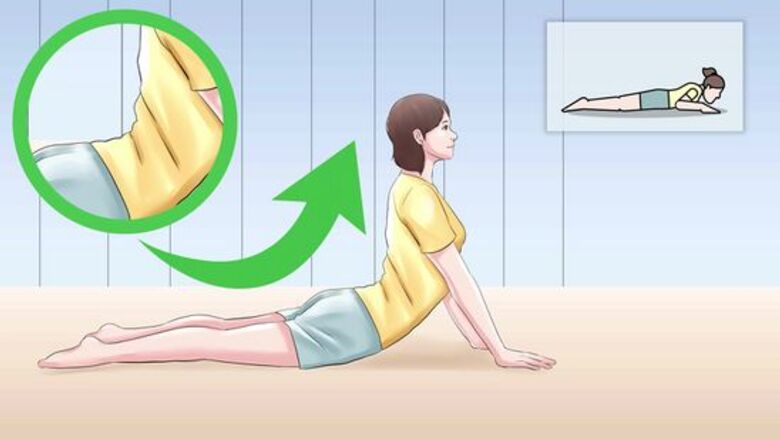
views
Doing Static Stretches

Try the cobra pose. Start by lying on the floor face down with your hands under your shoulders. Keep your hips on the floor as you lift your upper body with your arms so your chest is out and you’re facing forward. Hold the stretch for 20 to 30 seconds, return to the resting position, then repeat 2 to 4 times.Lengthen your spine as you stretch. If you feel pressure, compression, or discomfort in backward bending yoga postures like cobra, you should work more on stretching out the length of your spine rather than arching your back. Keep your arms slightly bent at the elbow and try to make a curve with your entire spine instead of only bending your lower back. To get more out of the stretch, straighten your arms fully and lift your hips slightly off of the ground to enter the upward facing dog pose.
Do a standing ab stretch. Stand tall with your feet hip width apart. Reach your arms above your head as far out as you can. Lean back and arch your spine to open your abs and chest. Hold the stretch for 20 to 30 seconds, then repeat 2 to 4 more times. Make sure you don't lose your balance as you lean backward.
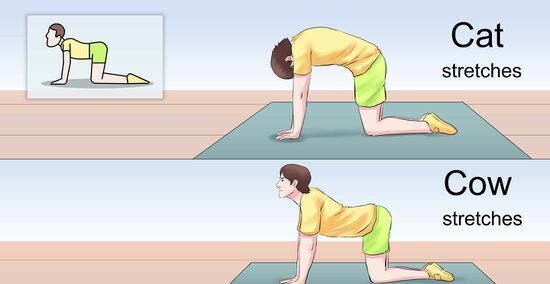
Do cat and cow stretches for your abs and core. Start on all fours with your hands under your shoulders and your knees under your hips. Engage your abs to arch your spine toward the ceiling like an angry cat hunching its back. Tuck your chin toward your chest and hold the pose for 20 to 30 seconds.PNote: To enter the cow pose from the cat pose, bring your head up, lower your abdomen toward the floor, and point your tailbone toward the ceiling. Hold the pose for 20 to 30 seconds, then repeat each pose an additional 2 to 4 times.
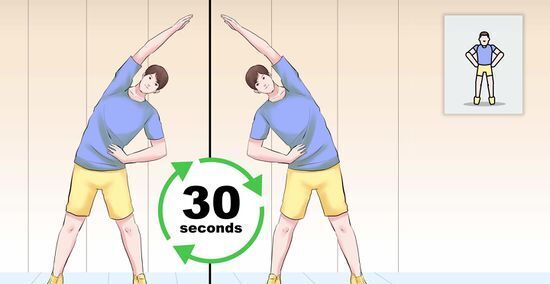
Don’t forget to stretch your obliques. Stand with your feet hip width apart and knees slightly bent instead of locked. Raise your left arm and place your right hand on your hip. Lean your torso toward the right while keeping your hips still until you feel a stretch in your left obliques, or the muscles on the left side of your abdomen. Hold the stretch for 20 to 30 seconds, then repeat on the other side. Do an additional 2 to 4 repetitions per side.
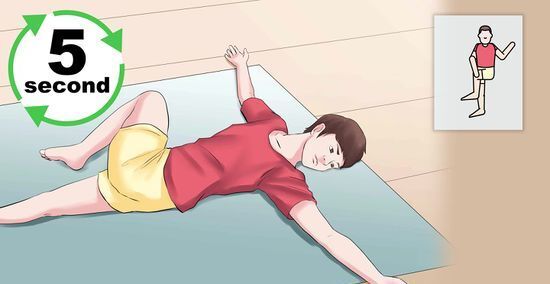
Do a twisting crocodile stretch. Lay down on an exercise mat or carpet with your back against the floor. Keep your right leg straight and bring your left leg up. Bend the knee, placing the left foot flat against the front of your right ankle. Stretch your arms out to your sides. Look to the left, then slowly twist your hips to the right. Hold the stretch for 5 seconds, then repeat 5 times on each side.
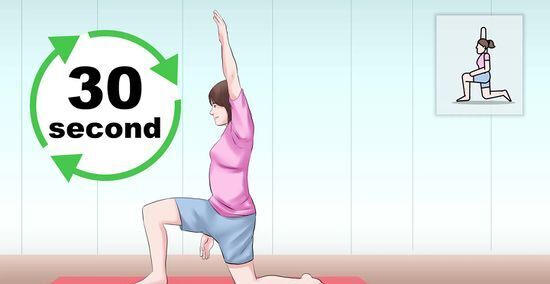
Add in hip flexor stretches. Start in a right forward lunge position, then slowly lower yourself down onto your left knee. Keep your hips tucked and your glutes squeezed as you lower your body. Raise your left arm, then shift your hips slightly forward. Increase the stretch by leaning slightly to your right. Hold the stretch for 20 to 30 seconds. Switch sides, then repeat the stretch on each side 2 to 4 times.
Doing Dynamic Stretches
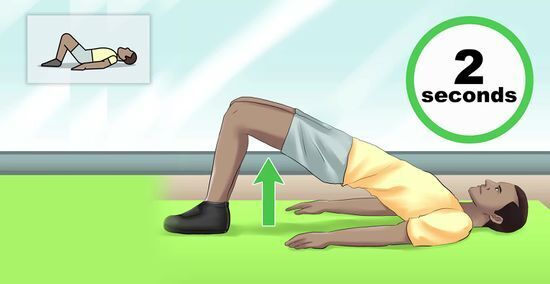
Do 15 glute bridges after an abs workout. Lie on your back with your arms by your sides, knees bent, and feet flat on the floor. Squeeze your glutes and lift your rear end off the floor to form a straight diagonal line from your shoulders to your knees. Hold the pose for 1 to 2 seconds then slowly lower your hips back to the floor.Tip: Glute bridges are great after a hard abs workout. In addition to stretching your abs, they move your body in the opposite direction as crunches or situps. This helps balance and stabilize your core muscles and spine.

Do standing side bends. Stand up straight with your feet hip width apart and knees slightly bent. Place your left hand behind your head and hold your right arm by your side. Pull your navel toward your spine and lean your torso to your right side as you lower your right arm to the floor. Hold the stretch for 2 or 3 seconds, slowly return to a resting position, then repeat on the other side. Do 10 repetitions on each side.
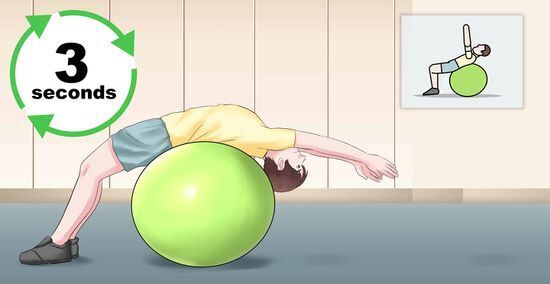
Use an exercise ball to stretch your abs. Lie on your back on the exercise ball with your knees and elbows bent and your hands by your chest. Push back with your feet to straighten your legs as you extend your arms over your head. Your body should make a long curve over the ball and you should feel a good stretch throughout your abdominals. Hold the stretch for 2 to 3 seconds, then return to the starting position. Do 10 to 15 repetitions.
Developing a Safe Stretching Routine
Warm up for 5 to 10 minutes before stretching. A light warm up activity will get your blood pumping, prepare your muscles for stretching, and prevent injury. A brisk walk, light jog, jumping jacks, and other aerobic exercises are great warm ups. It’s also good to stretch after a workout.
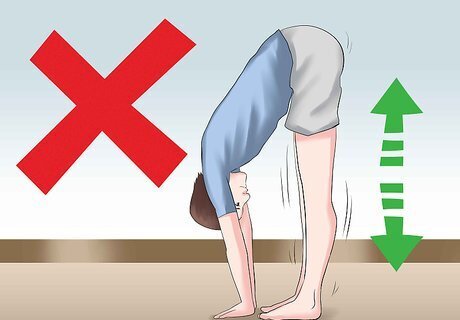
Don’t bounce while you stretch. Hold a stretch steadily instead of springing in and out of it. Bouncing when you stretch can lead to a pulled muscle or other injury.

Breathe while you stretch. Never hold your breath while stretching or doing any other exercise. Inhale as you move into a stretch pose, exhale as you stretch, then inhale again as you return to your starting position.
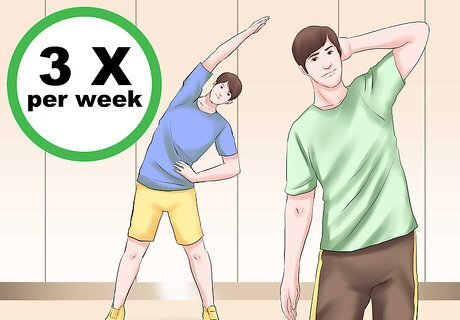
Stretch a muscle group for a few minutes 2 to 3 times per week. Stretching the same muscle group intensely every day poses an injury risk. Instead, stretch a different muscle group per day. Aim to stretch specific muscles for 2 to 3 minutes 2 to 3 days per week.Tip: You could focus on stretching your abs one day, target your legs the next day, and work on your chest, neck, and shoulders the day after that.
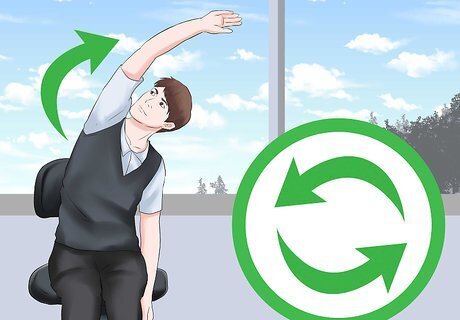
Take regular stretch breaks at work. Sitting in a chair or doing repetitive motions for long periods of time is hard on your body. You might not be able to do cobra, cat, or cow poses at the office, but you could incorporate side bends into a stretch break at work. Since you probably won’t have the opportunity to warm up, take it easy when you stretch at work.
Consult your doctor if you have an injury. Many people assume that stretching is good if you’re in pain or have a strained muscle. However, stretching an injured muscle can cause further damage. You should also consult your doctor before stretching or exercising if you have an injury or a history of heart, bone, or joint issues.




















Comments
0 comment